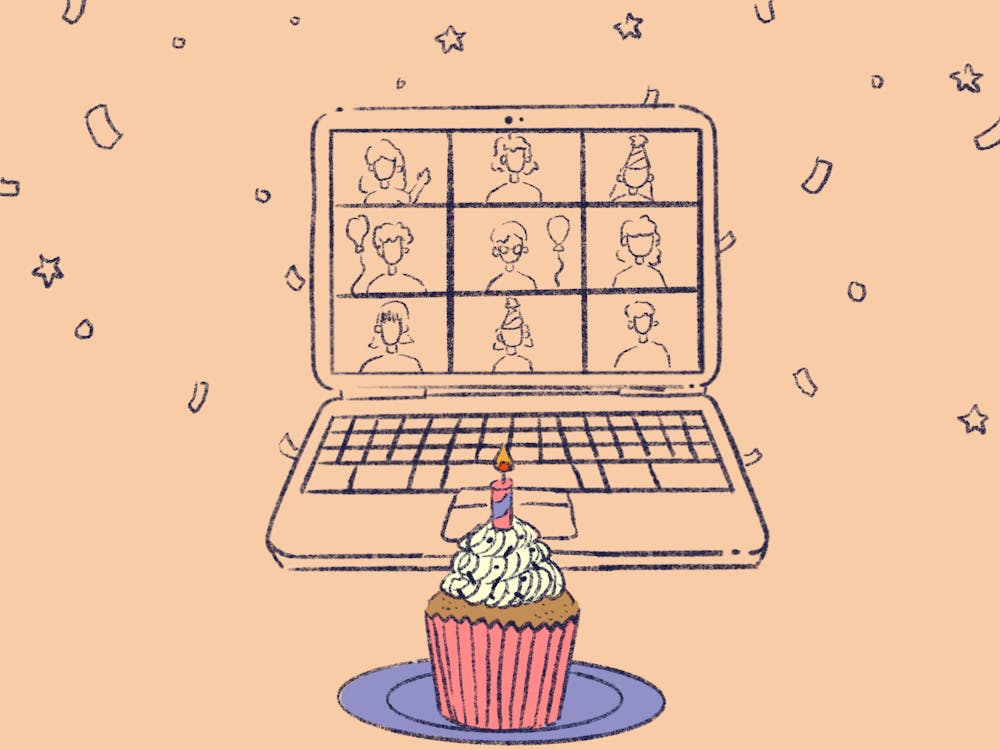It’s a Sunday morning in April and I—along with 40 others—am logged into Zoom, watching a friend open beautifully wrapped presents from her backyard, smiling as she reads cards with private jokes and well–wishes as she shows them to the camera. My friend’s bridal shower was scheduled to be in person, at the end of March, in advance of her May (now July) wedding. After postponing the event, her bridesmaids decided to host the shower over Zoom, resorting to the use of creative games to make the virtual celebration engaging.
Soon, a man enters the Zoom chat—my friend’s fiancé. Her bridesmaids facilitate the “Newlywed Game.” The groom mutes his phone while the bride answers a question. “Who controls the music in the car?” Then he unmutes his phone and they ask him the same question—hopefully he answers the same.
With COVID–19 restrictions banning gatherings of over 10 people in many states, life events that people are used to celebrating together through intimate gatherings or large parties are now being marked virtually—via softwares like FaceTime, livestream, or Zoom.
Tyler Daniels (C ’21), attended three of her friends’ 21st birthday parties over Zoom. Although they weren’t at a bar, getting to use their IDs for the first time, they still found ways to mark the occasion. On one Zoom, the host invited six people, which made for a more conversational vibe. Another friend decided to invite over 20 people and make the theme a “CostZoom” party. Everyone showed up in a different costume with the instruction of dressing up as someone born on April 29, the host's birthday. One of Tyler’s friends back home even made a Kahoot! Trivia game about herself, with questions like: “What are acceptable nicknames for me?” or “What is the name of that guy I dated?”
“Something like a birthday feels like a communal celebration, and I think the fact that we have to jump through extra hoops and get creative to celebrate it is really fun,” Tyler said. “It’s not going to be the same but I think it’s a good gesture and it’s nice to have all of your friends in one place even though it’s a virtual chat room.”
Mike Montague (C ‘20) was a virtual attendee at a wedding. While the bride, groom, and officiator were together in person, the the Zoom screen was filled with 80 other attendees, including friends, cousins, and even the parents of the bride and groom.
Mike definitely felt awkward, noting that “it’s weird when you do a service like that and everyone is sitting in their underwear.” But he was impressed with how the wedding party leaned into the strangeness of the situation. The invitation read: “Cocktail attire on top, pants optional.”
Mike also felt disconnected from the celebration. Instead of feeling like a participant, he felt like he was watching a program.
While Hana Wohlberg (C ‘23) also felt removed from the families of the funeral and Bar Mitzvahs that she attended over Zoom, she still felt a strong sense of togetherness from her Jewish community.
The funeral’s Zoom had 400 participants, so Hana estimates that around 800 people were watching. She felt the impact of the service and the community’s presence. The family sat together on one screen while other close friends unmuted their microphones to give their eulogies. But Hana still felt removed because there was “no face–to–face contact” with the grieving family during the service. Later, she visited the family outside of their house as they were sitting Shiva—seven days of Jewish mourning after a family member passes away—from behind a screen door.
She also attended a Bar Mitzvah. A Torah was brought to the bar mitzvah’s house and the family led the whole service themselves, while everyone watched and participated over Zoom. Later, they had everyone drive by their house to say congratulations. Another Bat Mitzvah had a virtual dance party over Zoom.
Bayley Tuch (C ‘21) also attended a Zoom Bar Mitzvah. The computer screen was split into two sections, one showing the family, while the other showed the Rabbi and Cantor. They screenshared a slideshow with the prayers so the participants could follow along. Bayley was enthusiastic about how “well–done” the virtual Bar Mitzvah was, noting that the virtual nature of the event made it more accessible. She lives in California, and the bar mitzvah lives in New Jersey. “If we were not in quarantine, probably only my dad would have flown to New Jersey.” All of her family members, even her dog, happily attended the special occasion.
Hana noticed how “people had to change their values to still be able to gather and see each other’s faces.” Her dad, a Rabbi, never used to use technology on the Sabbath. Now, he leads virtual Friday night services. She said, “it’s cool how in all these scenarios, the Jewish community is able to come together.”
Of virtual life events, Mike notes, “The way people express these milestones is still there, but it’s more complex.” Because it isn’t safe for many important people to be present at these occasions, “even the happiest moments have a bitter tinge.”







